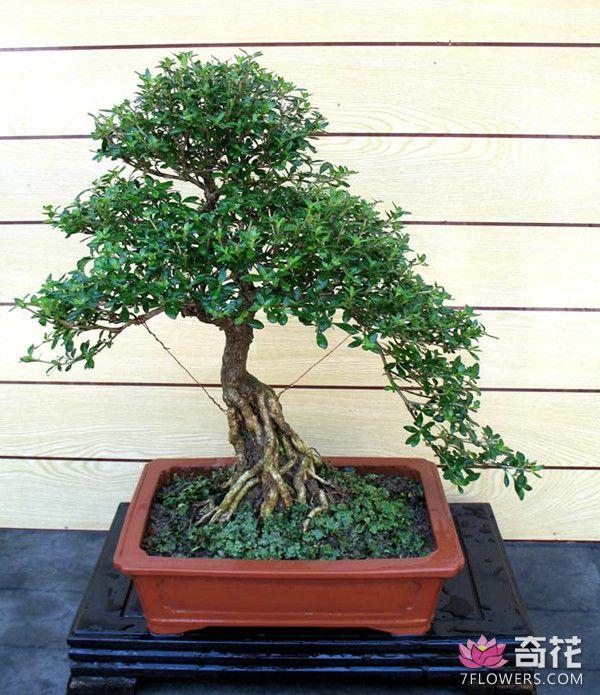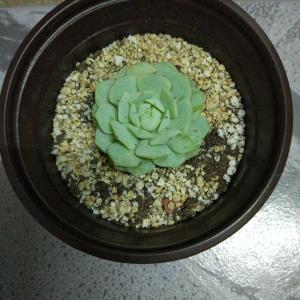文章
Colour_
2017年07月23日

黄金葛的繁育方法
绿萝主要用扦插法繁殖,春末夏初剪取15厘米至30厘米的枝条,将基部1节至2节的叶片去掉,用培养土直接盆栽,每盆3根至5根,浇透水,植于阴凉通风处,保持盆土湿润,一月左右即可生根发芽,当年就能长成具有观赏价值的植株。春夏季用枝条扦插容易生根;作图腾柱的必须用带大叶片的顶尖扦插,这样成型比较快。绿萝还可水栽,但与土栽相比植株较小。
黄金葛的养殖方法
一、绿萝以疏松、富含有机质的微酸性和中性沙壤土栽培发育最好。每三年换盆一次,绿萝属阴性植物,忌阳光直射,喜散射光,较耐阴,通常以接受四小时的散射光,绿萝的生长发育最好。
二、繁殖采用扦插和埋茎法。选取健壮的绿萝藤,剪成两节一段,注意不要伤及气根,然后插入素沙或煤渣中,深度为插穗的1/3,淋足水放置于荫蔽处,喷施新高脂膜保湿,提高成活率均在90%以上。
三、绿萝喜较大的空气湿度和湿润的环境。盛夏是绿萝的生长高峰,每天可向绿萝的气根和叶面喷雾数次,既可清洗叶片的尘埃,利于绿萝的呼吸,又能使叶色碧绿青翠,还能降低叶面温度,增加小环境的空气湿度,使叶片更好地生长,绿萝的施肥,以氮肥为主,钾肥为辅。喷施新高脂膜保肥保墒,冬季室温较低,绿萝处于休眠状态,应少浇水,保持盆土不干即可。
四、绿萝最适宜的生长温度为白天20℃-28℃,晚上15℃-18℃。冬季只要室内温度不低于10℃,绿萝即能安全越冬,如温度低于5,易造成落叶,影响生长。生长期适时喷施壮茎灵,可使植物杆茎粗壮、叶片肥厚、叶色鲜嫩、植株茂盛。
五、绿萝都是从广州运到全国各地的冬季买回来的,绿萝一般受过冻所以放在室内会出现很快黄叶现象等这些受冻的叶片黄完落完后春节还会重新发的。一般新买的绿萝到新环境都有1个月左右的适应期,底部黄叶属正常,不过切记:黄叶或死叶不要直接剥落掉要从叶柄中部剪断这样避免直接剥离造成过多水分流失和增加伤口;从而导致上部的叶片还会黄。
绿萝最下面的叶子发黄原因有多种:偶有出现是生长期正常代谢,但间隔时间较长;浇水过多或干旱;给水应见干见湿;秋凉后应停止给肥;在室内应注意光照和通风;冬季应适当喷水。另外,有的绿萝叶黄较多原因大都缘于根部,叶黄只是表象,根烂则叶黄。
冬季养护
绿萝性喜湿热,最佳的生长温度在20℃至30℃,在冬季为其营造适宜的生长环境,成为养护成败的关键。在养护上應注意以下几个方面:
光照:绿萝向阳性并不强,但在冬季,为了补充温度和光合作用的不足,应增加其光照。方法是把绿萝摆放到室内光照最好的地方,或在正午时搬到密封的阳台上晒太阳,同时温度低的时候要尽量少开窗,应为极短的时间内,叶片就可能被冻伤。
温度: 在北方,室温10℃以上,绿萝可安全越冬,室温在20℃以上,绿萝可以正常生长。一般家庭达到这个温度问题不大,需要注意的是要避免温差过大,同时也要注意叶子不要靠近供暖设备。
湿度: 在保证正常温度的条件下,加大湿度对植物的生长极为有利。增大湿度可以采用以下方法:使植物 靠近加湿器,加湿器每天的开放时间在5个小时以上;用调到雾状刻度的喷雾器向植物的叶片、茎部和气根处 喷水,每天若干次;在花盆托盘内保持适量水分,通过它的蒸发增加植物局部的湿度;用冷的湿毛巾或卫生 纸轻擦叶面或短时间内(每日1——2个小时)轻敷叶面;把透明的塑料薄膜罩在植株上,制造小温室的效 果,通过蒸发土壤中的水气补充植物的水分,每天不多于2小时,时间太长会影响植物的通气和光合作用。
水: 冬季的浇水量应根据室温严格控制。供暖之后,浇水也不可过勤,浇水要少向盆中浇,应由棕丝渗水。另外,还應向棕柱上气生根处喷水,减少应蒸发过快而引起的根部吸水不足。冬季浇的水以晾晒一天后的水比较好,过凉容易损伤根部。
肥; 冬季植物生长缓慢,應少施肥。入冬后,施肥以叶面喷施为主。叶面肥要用专用肥,普通无机肥不易被吸收,可使用北大护花神系列和日本出品的花一番等叶面肥。

黄金葛的养殖注意事项
水培黄金葛的要点
1、新剪下来的绿萝水培养殖需要多久才能长出根系?
大概一星期之内
2、新剪下来的绿萝水培养殖多久换一次水?
7-10天
3、施肥多久一次?
你要买那种水培驯养液 是促进水培花生根的 有消炎杀菌的作用 每次换水 都要加几滴进去
水培驯养液 不是营养液 别弄错了 花卉市场都有卖的 水培花的初期 一定要拿那个东西生根。

绿萝主要用扦插法繁殖,春末夏初剪取15厘米至30厘米的枝条,将基部1节至2节的叶片去掉,用培养土直接盆栽,每盆3根至5根,浇透水,植于阴凉通风处,保持盆土湿润,一月左右即可生根发芽,当年就能长成具有观赏价值的植株。春夏季用枝条扦插容易生根;作图腾柱的必须用带大叶片的顶尖扦插,这样成型比较快。绿萝还可水栽,但与土栽相比植株较小。
黄金葛的养殖方法
一、绿萝以疏松、富含有机质的微酸性和中性沙壤土栽培发育最好。每三年换盆一次,绿萝属阴性植物,忌阳光直射,喜散射光,较耐阴,通常以接受四小时的散射光,绿萝的生长发育最好。
二、繁殖采用扦插和埋茎法。选取健壮的绿萝藤,剪成两节一段,注意不要伤及气根,然后插入素沙或煤渣中,深度为插穗的1/3,淋足水放置于荫蔽处,喷施新高脂膜保湿,提高成活率均在90%以上。
三、绿萝喜较大的空气湿度和湿润的环境。盛夏是绿萝的生长高峰,每天可向绿萝的气根和叶面喷雾数次,既可清洗叶片的尘埃,利于绿萝的呼吸,又能使叶色碧绿青翠,还能降低叶面温度,增加小环境的空气湿度,使叶片更好地生长,绿萝的施肥,以氮肥为主,钾肥为辅。喷施新高脂膜保肥保墒,冬季室温较低,绿萝处于休眠状态,应少浇水,保持盆土不干即可。
四、绿萝最适宜的生长温度为白天20℃-28℃,晚上15℃-18℃。冬季只要室内温度不低于10℃,绿萝即能安全越冬,如温度低于5,易造成落叶,影响生长。生长期适时喷施壮茎灵,可使植物杆茎粗壮、叶片肥厚、叶色鲜嫩、植株茂盛。
五、绿萝都是从广州运到全国各地的冬季买回来的,绿萝一般受过冻所以放在室内会出现很快黄叶现象等这些受冻的叶片黄完落完后春节还会重新发的。一般新买的绿萝到新环境都有1个月左右的适应期,底部黄叶属正常,不过切记:黄叶或死叶不要直接剥落掉要从叶柄中部剪断这样避免直接剥离造成过多水分流失和增加伤口;从而导致上部的叶片还会黄。
绿萝最下面的叶子发黄原因有多种:偶有出现是生长期正常代谢,但间隔时间较长;浇水过多或干旱;给水应见干见湿;秋凉后应停止给肥;在室内应注意光照和通风;冬季应适当喷水。另外,有的绿萝叶黄较多原因大都缘于根部,叶黄只是表象,根烂则叶黄。
冬季养护
绿萝性喜湿热,最佳的生长温度在20℃至30℃,在冬季为其营造适宜的生长环境,成为养护成败的关键。在养护上應注意以下几个方面:
光照:绿萝向阳性并不强,但在冬季,为了补充温度和光合作用的不足,应增加其光照。方法是把绿萝摆放到室内光照最好的地方,或在正午时搬到密封的阳台上晒太阳,同时温度低的时候要尽量少开窗,应为极短的时间内,叶片就可能被冻伤。
温度: 在北方,室温10℃以上,绿萝可安全越冬,室温在20℃以上,绿萝可以正常生长。一般家庭达到这个温度问题不大,需要注意的是要避免温差过大,同时也要注意叶子不要靠近供暖设备。
湿度: 在保证正常温度的条件下,加大湿度对植物的生长极为有利。增大湿度可以采用以下方法:使植物 靠近加湿器,加湿器每天的开放时间在5个小时以上;用调到雾状刻度的喷雾器向植物的叶片、茎部和气根处 喷水,每天若干次;在花盆托盘内保持适量水分,通过它的蒸发增加植物局部的湿度;用冷的湿毛巾或卫生 纸轻擦叶面或短时间内(每日1——2个小时)轻敷叶面;把透明的塑料薄膜罩在植株上,制造小温室的效 果,通过蒸发土壤中的水气补充植物的水分,每天不多于2小时,时间太长会影响植物的通气和光合作用。
水: 冬季的浇水量应根据室温严格控制。供暖之后,浇水也不可过勤,浇水要少向盆中浇,应由棕丝渗水。另外,还應向棕柱上气生根处喷水,减少应蒸发过快而引起的根部吸水不足。冬季浇的水以晾晒一天后的水比较好,过凉容易损伤根部。
肥; 冬季植物生长缓慢,應少施肥。入冬后,施肥以叶面喷施为主。叶面肥要用专用肥,普通无机肥不易被吸收,可使用北大护花神系列和日本出品的花一番等叶面肥。

黄金葛的养殖注意事项
水培黄金葛的要点
1、新剪下来的绿萝水培养殖需要多久才能长出根系?
大概一星期之内
2、新剪下来的绿萝水培养殖多久换一次水?
7-10天
3、施肥多久一次?
你要买那种水培驯养液 是促进水培花生根的 有消炎杀菌的作用 每次换水 都要加几滴进去
水培驯养液 不是营养液 别弄错了 花卉市场都有卖的 水培花的初期 一定要拿那个东西生根。

0
0
文章
Colour_
2017年07月23日

盆栽火龙果的养殖方法

1、将火龙果挖出果肉
2、加入清水泡一天
3、装入丝袜里,反复冲洗捏挤
4、再仔细冲洗,直到火龙果种子沉入容器的底部
5、沥干水分
6、将底部没有的孔的容器下部铺上10公分高的一层小石子,上面填好无菌土壤
7、撒上火龙果种子,喷洒适量水
8、 盖上一层膜密封,每天将膜敞开透透气,然后再盖上,一个星期后长出很多芽来

火龙果盆栽种植养护
1.火龙果种子的最佳发芽温度是25度左右。
2.一个中等大小的火龙果的种子,至少可以制作10盆这样的小盆栽,按照自己的需要来取用种子就好了。
3.要选择颗粒比较幼细的培养土,也可以用市售的播种土代替。
4.一定要将附在种子上的果肉和胶质清除干净,否则发芽时易长霉菌。
5.做造型小盆栽,种子要铺得密一些,尤其是边缘的部分,否则种出来稀稀松松,会失去美感。
6.因为杯子没有底孔,所以不要用水壶直接浇水以免浇水过量,2-3天用喷壶喷一次就可以了。

1、将火龙果挖出果肉
2、加入清水泡一天
3、装入丝袜里,反复冲洗捏挤
4、再仔细冲洗,直到火龙果种子沉入容器的底部
5、沥干水分
6、将底部没有的孔的容器下部铺上10公分高的一层小石子,上面填好无菌土壤
7、撒上火龙果种子,喷洒适量水
8、 盖上一层膜密封,每天将膜敞开透透气,然后再盖上,一个星期后长出很多芽来

火龙果盆栽种植养护
1.火龙果种子的最佳发芽温度是25度左右。
2.一个中等大小的火龙果的种子,至少可以制作10盆这样的小盆栽,按照自己的需要来取用种子就好了。
3.要选择颗粒比较幼细的培养土,也可以用市售的播种土代替。
4.一定要将附在种子上的果肉和胶质清除干净,否则发芽时易长霉菌。
5.做造型小盆栽,种子要铺得密一些,尤其是边缘的部分,否则种出来稀稀松松,会失去美感。
6.因为杯子没有底孔,所以不要用水壶直接浇水以免浇水过量,2-3天用喷壶喷一次就可以了。
1
0
文章
权问薇
2017年07月23日


文竹
1.想要文竹多开花多结果,要在生长期间多追施含有氮磷的复合肥,其它液肥也可以。开花期间不要追施太多的肥料,可以每两个月追施一次液肥。
2.把收集好的文竹种子浸泡在水里一段时间,促进发芽。
3.准备疏松肥沃的土壤,可以用腐叶土或泥炭土都可以。
4.把种子均匀的撒到土壤中,上面盖上两三厘米的土壤,浇透水,在花盆上方罩一层塑料袋,用来保湿。
5.保持土壤湿润,一个月左右就会发芽,发芽之后,将塑料袋去掉,把花盆放到散射光处通风。
6.随着小苗继续长大,可以缓慢的增加光照,促进枝叶的生长。
7.等到小苗长出散状的叶子时,便可以上盆移栽啦。
8.这样繁殖文竹又快又简单,很快你就成了文竹大户啦。
君子兰
除了文竹,我们熟悉的君子兰开花后,结的的种子也可以自己播种的哦。
1.君子兰种子成熟后,将种子从果肉种清理出来,放在光照充足的地方晾晒两天。
2.找一些新的刨花,就是做家居木材上刨下来的锯末。
1
0
文章
权问薇
2017年07月23日


栀子
1、选取健壮的栀子花枝条,最好是当年新生的嫩枝然后截去8~10cm左右的一条即可。
2、将枝条的下半部分斜切,好漏出更多的横截面,能够促进生根。
3、准备一个塑料瓶或者是杯子,或者是其他不漏水的容器。
4、将栀子花的枝条插进水中即可。(如果容器的口比较大,可以和图中一样,用塑料泡沫固定住,然后浮在水面上即可)
5、夏天天气炎热,因此要一天换一次水,大概半个月或者是1个月的时间就可以生根了!
6、生根后,大概有2条三公分左右的白根就可以移栽了!
虎皮兰
1、选取健康的虎皮兰叶片,从顶部剪下来6~7cm的一截。
2、准备好不漏水的容器。
3、将虎皮兰伤口处在多菌灵溶液中浸泡15分钟左右,然后阴干。
4、将虎皮兰插进水里即可~
5、在生根之前记得每天换水哦~大概半个月的时间,虎皮兰就能生根了,然后上盆即可。
幸福树
1、选择健壮的1~2年生幸福树枝条,注意是要木质化的哦~取15~20cm左右即可~
2、将伤口处放在高锰酸钾溶液中浸泡半个小时左右,然后阴干。
3、将容器清洗干净,倒入干净的水。
4、将幸福树的枝条插进土壤中即可,不过,在没有生根之前,要一天换一次水哦~
5、大概半个月或者是一个月左右的时间,就能生根了!
发财树
1、选取一截比较健壮的发财树枝条哦~然后用多菌灵消毒杀菌。
2、准备干净的容器,装上水,大概三分之二就可以了~
3、将发财树的枝条插进去即可,注意一天换一次水哦~
薄荷
1、选取健壮枝条,剪下来吗,记得留最少2个节点哦~
2、将扦插用的容器清洗干净,装满水。将薄荷插进水里即可。
3、薄荷生根真的超级快,基本上2天就会有根冒出来了!
0
1
文章
权问薇
2017年07月23日


1缺水
表现:叶梢、叶边缘发干,并且枯黄,新生的嫩叶正常,但是下部的老叶却枯黄脱落。
解决办法:立刻浇水,一次性浇透,一定要看见水从下面的孔里流出来。
2水太多
表现:叶子整体黯淡无光,色泽偏黄,而且新长出来的叶子,顶稍部分梢萎缩。
解决办法:停止浇水,用铲子或者是钩子松一下土,同时放到散射光充足,并且通风良好的地方,好让水分尽快蒸发。
3光照问题
表现:无论新叶还是老叶都整体偏黄,如果在叶子上发现了灼伤的痕迹,说明光照非常强烈。
解决办法:摆放在光线明亮的客厅,散射光充足,而且不用接受太阳直射!
4肥太多
表现:叶片肥厚,但是黯淡,且下部的老叶片开始泛黄脱落。
解决办法:刚施肥就发现施肥过多,可用清水冲洗盆土,让多余肥料溶解在水中,然后顺着水流从下面的小孔流出来。
如果施肥很久之后才发现,那就只能换土了。
以后施肥的时候要注意薄肥勤施哦~
5肥太少
表现:绿萝的叶子显示颜色变淡,变成淡绿色,而后缓缓地变成黄色,一般从根部的叶子开始,然后慢慢蔓延到顶部叶片。
解决办法:平时可以给绿萝浇已经充分腐熟的淘米水、豆饼水等等,淘米水按照1:4的比例进行浇花,1周1~2次即可;豆饼水按照1:50的比例兑水稀释,1周1次即可。
绿萝换盆时埋进去一些缓释肥,也可以1个月左右埋进去一小把缓释肥,但是不能接触到绿萝的根部。
6烂根
表现:叶子发黄、倒伏、萎蔫,比较严重的甚至能够看到已经腐烂的茎干。
解决办法:如果烂根情况不是很严重,将根部腐烂的地方切掉,然后消毒杀菌后,重新上盆即可,注意,盆土要更换成新的哦
烂根的特别厉害,选取比较健康的枝条,消毒后重新扦插即可,或者是水插。
1
2
文章
Dummer. ゛☀
2017年07月22日

Family - Scrophulariaceae
Stems - To +1m tall, erect, herbaceous but stout, terete near the base, angled in the apical 1/2, scaberulous, puberulent, much-branched, from a big taproot, mostly green.

Leaves - Opposite, linear, entire, antrorse strigose, acute, to +3cm long, 1-1.5mm broad, slightly folded, with well developed axillary fascicles. Fascicles as long or longer than the subtending leaf.

Inflorescence - Axillary racemes in the upper 2/3 of the stem. Racemes very bracteate and the inflorescence appearing as just axillary flowers. Flowers single from each leaf (bract) axil, 1-2 per node, opposite. Pedicels 3-5mm long, shorter than or equaling the calyx, glabrous, ascending. Axis of the inflorescence angled, puberulent.
Flowers - Corolla pink, to +2cm long, 5-lobed. Corolla tube densely antrorse pubescent externally, mostly glabrous internally, contracted in the basal 5mm (the portion surrounded by the calyx). Corolla tube with pink spots and two yellow stripes internally (ventrally). Corolla lobes rounded, with pilose margins, to +1cm broad, 1cm long, spreading, the upper two pilose-bearded at the base internally. Stamens 4, didynamous, mostly included. Filaments pale pink to whitish, pink pilose, to +1cm long, adnate at the apex of the contracted portion of the corolla tube. Anthers whitish, pilose dorsally, +/-3mm long, 1.5mm broad, with two acute basal lobes. Style 1, exserted beyond the corolla and from between the stamens, pale purple basally, whitish at the apex, mostly glabrous and terete, flattened and puberulent on the margins in the apical 1/3 (the stigma). Ovary superior, green, glabrous, ovoid, to 2mm long in flower, 2-locular, with many ovules. Placentation axile. Calyx campanulate, green, glabrous, 5mm long in flower, 5-lobed. Lobes 1-1.6mm long, triangular-attenuate with a slight keel that somewhat ribs the calyx tube in the apical 1/2. Most dorsal calyx lobe slightly larger than the others.

Flowering - August - October.
Habitat - Prairies, sandy open ground, thickets, woodland edges, fallow fields.
Origin - Native to U.S.
Other info. - This striking species can be found mainly in southwestern Missouri. The plant can be identified by its big flowers (which have yellow stripes and pink spots internally), and its linear leaves which have well developed axillary fascicles. The plant is very common in states to the south and east and extends up the east coast to Maryland. This species reaches its inland northern limit in Missouri.
A synonym for this species is Gerardia fasciculata Ell.
Stems - To +1m tall, erect, herbaceous but stout, terete near the base, angled in the apical 1/2, scaberulous, puberulent, much-branched, from a big taproot, mostly green.

Leaves - Opposite, linear, entire, antrorse strigose, acute, to +3cm long, 1-1.5mm broad, slightly folded, with well developed axillary fascicles. Fascicles as long or longer than the subtending leaf.

Inflorescence - Axillary racemes in the upper 2/3 of the stem. Racemes very bracteate and the inflorescence appearing as just axillary flowers. Flowers single from each leaf (bract) axil, 1-2 per node, opposite. Pedicels 3-5mm long, shorter than or equaling the calyx, glabrous, ascending. Axis of the inflorescence angled, puberulent.
Flowers - Corolla pink, to +2cm long, 5-lobed. Corolla tube densely antrorse pubescent externally, mostly glabrous internally, contracted in the basal 5mm (the portion surrounded by the calyx). Corolla tube with pink spots and two yellow stripes internally (ventrally). Corolla lobes rounded, with pilose margins, to +1cm broad, 1cm long, spreading, the upper two pilose-bearded at the base internally. Stamens 4, didynamous, mostly included. Filaments pale pink to whitish, pink pilose, to +1cm long, adnate at the apex of the contracted portion of the corolla tube. Anthers whitish, pilose dorsally, +/-3mm long, 1.5mm broad, with two acute basal lobes. Style 1, exserted beyond the corolla and from between the stamens, pale purple basally, whitish at the apex, mostly glabrous and terete, flattened and puberulent on the margins in the apical 1/3 (the stigma). Ovary superior, green, glabrous, ovoid, to 2mm long in flower, 2-locular, with many ovules. Placentation axile. Calyx campanulate, green, glabrous, 5mm long in flower, 5-lobed. Lobes 1-1.6mm long, triangular-attenuate with a slight keel that somewhat ribs the calyx tube in the apical 1/2. Most dorsal calyx lobe slightly larger than the others.

Flowering - August - October.
Habitat - Prairies, sandy open ground, thickets, woodland edges, fallow fields.
Origin - Native to U.S.
Other info. - This striking species can be found mainly in southwestern Missouri. The plant can be identified by its big flowers (which have yellow stripes and pink spots internally), and its linear leaves which have well developed axillary fascicles. The plant is very common in states to the south and east and extends up the east coast to Maryland. This species reaches its inland northern limit in Missouri.
A synonym for this species is Gerardia fasciculata Ell.
0
0
文章
蒋欣
2017年07月19日

盆景制作
#六月雪 喜半阴,怕积水,畏烈日,抗性较强,盆栽必须选用松软山土,应放置在向阳处,不能久放室内。在生长期需施1~2次肥料,盆土宜偏干些为好,肥水过多过浓会引起枝叶徒长。具有叶细、枝密、干粗、根露的特点,故作为盆景的佳材之一。六月雪的枝干软而韧,能经受蟠扎,分为直乾式、虬曲式、悬崖式等。如盆体高,可育成悬崖式。悬崖式因倾斜度的大小不同又分为半悬、全悬、小悬。所谓半悬,即树乾基本上横出盆口。全悬的树干得垂下盆口45度。小悬的树乾一般则垂下30度至40度左右。也可自然式,略加修整。

繁殖以扦插为主,也可用压条、分株、扦插等法,一般是初春季节用硬枝,但在梅雨季节用缴枝、老枝均可,在制作小型或微型盆景时,为促使其尽快成型,常在6-7月梅雨季节,取姿态优美,有大树型的多年生枝,将下切口剪成马蹄形,插入经石或砂中,罩膜保温,注意喷水,约40天可生根,此时加以移植,稍加绑扎修剪即可成型。由於此草山野各地容易觅得,所以有些养花者常从林问直接挖取回来上盆。
六月雪适应性强,栽培养护较简单,但因其畏烈日暴晒,生长期宜放置在半阴湿润的树阴等处,否则会因光照太强而影响生长,不利观赏。此草虽较喜肥,但若施肥过多,使发枝过旺,易引起新枝徒长,一般只在入冬前和花後各施一次腐熟的饼肥水。它有一定的耐旱能力,却不耐水湿,浇水要掌握问於问湿、不於不浇的原则,雨季要防盆中积水,若在多雨天气,应将盆侧放;夏季高温乾燥时节,早晚要向叶面喷水降温,增加空气湿度,以利其生长开花。
因六月雪的萌发力特强,主干及根部都会萌发出许多新枝,要及时剥除多余的新技,以免消耗养分,扰乱树形正常发育。对花后萌发的突出树冠外的枝条,也要加以修剪,否则影响观赏。
六月雪在冬季若保持5℃以上,则枝叶葱绿常青,但土壤不能大干,要使其稍微湿润些。

盆景制作方法
桩材来源
春季3月份进行分株繁殖,4-10月进行扦插(枝插或根插)繁殖,若采用保护地(苗床)繁殖,可在11月至翌年1月进行扦插。在我国东南部和中部各省区,还可到野外挖掘野生树桩培育加工。
加工造型
可采用“蓄木截干法”加工,也可采用“剪扎结合法”加工造型。蟠扎常在冬季半落叶后至春季萌芽前进行,主干和主枝用金属丝蟠扎,小枝经精细修剪成型。
移栽上盆
宜在2-3月进行移栽上盆,也可在梅雨季节及深秋进行。选用较浅的圆形、方形或椭圆形的紫砂盆或釉盆,盆色宜略深一些,与花色形成对比。盆土要求为富含有机质、疏松肥沃、排水透气性能良好的沙壤土,可用腐殖土、松针土、草炭掺进40%的沙或稻壳灰混合配制。

水肥管理
生长季节应经常浇水,保持盆土湿润,不宜长时间过干或过湿,切忌盆内积水或盆土失水,夏季每天往叶面喷水1-2次;冬季应适当减少浇水次数,保持盆土湿润稍偏干即可。每年4-5月浇施2-3次0.5%浓度的磷钾肥液;在腊冬追施1-2次稀薄的有机肥液,其它季节不宜施肥。忌施浓肥。
光温要求
生长期宜放在阳光充足,温暖湿润,通风良好的地方养护,夏季初秋应遮阳50%-70%,忌暴晒,冬季在南方可室外越冬,北方应移入室内,保持室温5-12℃为好。
翻盆与修剪
隔1-2年翻盆1次,于春季2-3月或深秋期间进行,剔去全部旧土,适当修剪根部。可结合翻盆进行提根,使其形成悬根,提高观赏价值。每年冬季半落叶后至翌春萌芽前,进行1次整形修剪,剪短长枝、徒长枝,疏去过密的细弱枝,剪去病虫枝以及其它影响观赏的杂乱枝;生长期适时进行摘心、抹芽、除分枝等,使其保持优美的造型。剪下的健康枝条可用于扦插繁殖。
病虫害防治
六月雪盆景的病虫害较少,偶有蚜虫和蜗牛发生。蚜虫可用风油精稀释500-600倍液喷杀;蜗牛可用58%风雷激乳油1500倍液喷杀。有时会发生根腐病,在初发病时可用12%松脂酸铜乳油600-1000倍液,或50%根腐灵800倍液灌根和叶面喷雾防治,每隔3-5天喷(灌)1次,连续喷(灌)3-4次。
#六月雪 喜半阴,怕积水,畏烈日,抗性较强,盆栽必须选用松软山土,应放置在向阳处,不能久放室内。在生长期需施1~2次肥料,盆土宜偏干些为好,肥水过多过浓会引起枝叶徒长。具有叶细、枝密、干粗、根露的特点,故作为盆景的佳材之一。六月雪的枝干软而韧,能经受蟠扎,分为直乾式、虬曲式、悬崖式等。如盆体高,可育成悬崖式。悬崖式因倾斜度的大小不同又分为半悬、全悬、小悬。所谓半悬,即树乾基本上横出盆口。全悬的树干得垂下盆口45度。小悬的树乾一般则垂下30度至40度左右。也可自然式,略加修整。

繁殖以扦插为主,也可用压条、分株、扦插等法,一般是初春季节用硬枝,但在梅雨季节用缴枝、老枝均可,在制作小型或微型盆景时,为促使其尽快成型,常在6-7月梅雨季节,取姿态优美,有大树型的多年生枝,将下切口剪成马蹄形,插入经石或砂中,罩膜保温,注意喷水,约40天可生根,此时加以移植,稍加绑扎修剪即可成型。由於此草山野各地容易觅得,所以有些养花者常从林问直接挖取回来上盆。
六月雪适应性强,栽培养护较简单,但因其畏烈日暴晒,生长期宜放置在半阴湿润的树阴等处,否则会因光照太强而影响生长,不利观赏。此草虽较喜肥,但若施肥过多,使发枝过旺,易引起新枝徒长,一般只在入冬前和花後各施一次腐熟的饼肥水。它有一定的耐旱能力,却不耐水湿,浇水要掌握问於问湿、不於不浇的原则,雨季要防盆中积水,若在多雨天气,应将盆侧放;夏季高温乾燥时节,早晚要向叶面喷水降温,增加空气湿度,以利其生长开花。
因六月雪的萌发力特强,主干及根部都会萌发出许多新枝,要及时剥除多余的新技,以免消耗养分,扰乱树形正常发育。对花后萌发的突出树冠外的枝条,也要加以修剪,否则影响观赏。
六月雪在冬季若保持5℃以上,则枝叶葱绿常青,但土壤不能大干,要使其稍微湿润些。

盆景制作方法
桩材来源
春季3月份进行分株繁殖,4-10月进行扦插(枝插或根插)繁殖,若采用保护地(苗床)繁殖,可在11月至翌年1月进行扦插。在我国东南部和中部各省区,还可到野外挖掘野生树桩培育加工。
加工造型
可采用“蓄木截干法”加工,也可采用“剪扎结合法”加工造型。蟠扎常在冬季半落叶后至春季萌芽前进行,主干和主枝用金属丝蟠扎,小枝经精细修剪成型。
移栽上盆
宜在2-3月进行移栽上盆,也可在梅雨季节及深秋进行。选用较浅的圆形、方形或椭圆形的紫砂盆或釉盆,盆色宜略深一些,与花色形成对比。盆土要求为富含有机质、疏松肥沃、排水透气性能良好的沙壤土,可用腐殖土、松针土、草炭掺进40%的沙或稻壳灰混合配制。

水肥管理
生长季节应经常浇水,保持盆土湿润,不宜长时间过干或过湿,切忌盆内积水或盆土失水,夏季每天往叶面喷水1-2次;冬季应适当减少浇水次数,保持盆土湿润稍偏干即可。每年4-5月浇施2-3次0.5%浓度的磷钾肥液;在腊冬追施1-2次稀薄的有机肥液,其它季节不宜施肥。忌施浓肥。
光温要求
生长期宜放在阳光充足,温暖湿润,通风良好的地方养护,夏季初秋应遮阳50%-70%,忌暴晒,冬季在南方可室外越冬,北方应移入室内,保持室温5-12℃为好。
翻盆与修剪
隔1-2年翻盆1次,于春季2-3月或深秋期间进行,剔去全部旧土,适当修剪根部。可结合翻盆进行提根,使其形成悬根,提高观赏价值。每年冬季半落叶后至翌春萌芽前,进行1次整形修剪,剪短长枝、徒长枝,疏去过密的细弱枝,剪去病虫枝以及其它影响观赏的杂乱枝;生长期适时进行摘心、抹芽、除分枝等,使其保持优美的造型。剪下的健康枝条可用于扦插繁殖。
病虫害防治
六月雪盆景的病虫害较少,偶有蚜虫和蜗牛发生。蚜虫可用风油精稀释500-600倍液喷杀;蜗牛可用58%风雷激乳油1500倍液喷杀。有时会发生根腐病,在初发病时可用12%松脂酸铜乳油600-1000倍液,或50%根腐灵800倍液灌根和叶面喷雾防治,每隔3-5天喷(灌)1次,连续喷(灌)3-4次。
0
1
文章
Miss Chen
2017年07月19日


Nombre científico o latino: Capparis spinosa
Nombre común o vulgar: Alcaparra, Alcaparrera, Alcaparro, Caparra
Familia: Caparidaceae.
Origen: Sur de Europa, Región mediterránea.
La alcaparra es un arbusto de hoja perenne de 1-1,5 m de altura.
Hojas alternas y ovales con la estípula transformada en una corta espina arqueada;
Flores muy decorativas, grandes, de color blanco rosado con largos estambres que emergen de la corola y se abren en verano.
Se conoce porque se aprovechan para consumo humano las alcaparras.
Los capullos (alcaparras) y los frutos (alcaparrones) se recolectan para consumo, habitualmente conservados en salmuera.

Se le atribuyen propiedades medicinales como diurético, depurativo, antihemorroidal y vasoconstrictora.
Tambien se ha usado un extracto de raiz en cosmetica para fortalecer el pelo.
En el medio natural se encuentra en taludes sobre suelos margosos en climas secos. Sobre murallas, torres y acantilados marinos.
Es adecuada para jardines rocosos (rocallas), adornar paredes pedregosas, muros, etc.
Luz: a pleno sol.
Terreno: pobre, formado de materiales de descomposición de rocas, piedras, con la adición de un poco de arena.
Multiplicación: se reproduce mediante semillas que se depositan entre las grietas de los muros o rocas.
0
0
文章
Dummer. ゛☀
2017年07月19日

Family - Asteraceae
Stems - Herbaceous, erect, to +60cm tall, from a thick caudex, simple below but branching in the apical 1/2 (inflorescence), terete, 2-4mm n diameter, typically multiple from the base, glabrescent at the base, scabrous and pubescent in the apical 1/2, with many small antrorse multicellular (use a lens to see) trichomes, light green and often with darker green vertical striations.

Leaves - Alternate, petiolate. Lowest leaves long petiolate. Petioles narrowly winged by decurrent leaf tissue, mostly glabrous. Blades linear-elliptic, with a few coarse but shallow teeth or entire, somewhat scabrous from the thickened bases of the hairs, antrorse strigillose on the margins. Leaf and petiole combined to +15cm long, 1cm broad. Cauline leaves reduced upward, becoming scale-like in the inflorescence. All leaves with a cartilaginous margin approximately .1mm broad. Light from underneath to see this.
Inflorescence - Corymbose arrangement of flower heads. Peduncles bracteate with reduced leaves, often with some arachnoid pubescence.
Involucre -To +/-6mm long and broad, cupulate to cylindric. Phyllaries imbricate, appressed, oblong, acute at the apex, to 5mm long, 1.4mm broad, glabrous externally, with a few appressed hairs or glabrous internally. Margins entire or minutely ciliolate, mostly scarious in the middle portion, with darker green apices, pale at the base.

Ray flowers - +/-12 per flower head, pistillate, fertile. Ligules glabrous, white, 5-7mm long, 2-3mm broad. Corolla tube white, +/-2mm long, glabrous. Pistil glabrous, becoming purple towards the apex, to 2.7mm long, bifurcate at the apex for +/-.4mm. Achene to +1mm long in flower, white, glabrous. Pappus of numerous capillary bristles. Bristles white, barbellate, -5mm long.
Disk flowers - Disk 6mm broad, with many flowers. Corolla 4mm long, pale yellow in the apical 1/2, greenish basally, glabrous externally and internally, 5-lobed. Lobes acute, .5mm long, erect to slightly spreading. Stamens 5, adnate at the base of the corolla tube. Filaments translucent, 2-2.2mm long, glabrous, compressed. Anthers connate around the style, 1.5-1.9mm long, yellow, drying to brown. Style to 4mm long, greenish-translucent, glabrous, bifurcate in the apical 1mm. The stigmas erect. Achenes glabrous, ribbed, 1-1.3mm long in flower, greenish-white. Pappus of capillary bristles. Bristles barbellate, to 4mm long, white. Receptacle flat, naked, -2mm broad.

Flowering - July - September.
Habitat - Rocky prairies, glades, bluffs, rocky open woods.
Origin - Native to U.S.
Other info. - This small species of Solidago can be found in the Ozark region of Missouri. The plant is unusual for a Goldenrod as the flowers are white instead of the typical yellow, and the flower heads are quite large for a Solidago. Because of these characteristics, the plant used to belong to the genus Aster. The old name was Aster ptarmicoides (Nees) T. & G.
Stems - Herbaceous, erect, to +60cm tall, from a thick caudex, simple below but branching in the apical 1/2 (inflorescence), terete, 2-4mm n diameter, typically multiple from the base, glabrescent at the base, scabrous and pubescent in the apical 1/2, with many small antrorse multicellular (use a lens to see) trichomes, light green and often with darker green vertical striations.

Leaves - Alternate, petiolate. Lowest leaves long petiolate. Petioles narrowly winged by decurrent leaf tissue, mostly glabrous. Blades linear-elliptic, with a few coarse but shallow teeth or entire, somewhat scabrous from the thickened bases of the hairs, antrorse strigillose on the margins. Leaf and petiole combined to +15cm long, 1cm broad. Cauline leaves reduced upward, becoming scale-like in the inflorescence. All leaves with a cartilaginous margin approximately .1mm broad. Light from underneath to see this.
Inflorescence - Corymbose arrangement of flower heads. Peduncles bracteate with reduced leaves, often with some arachnoid pubescence.
Involucre -To +/-6mm long and broad, cupulate to cylindric. Phyllaries imbricate, appressed, oblong, acute at the apex, to 5mm long, 1.4mm broad, glabrous externally, with a few appressed hairs or glabrous internally. Margins entire or minutely ciliolate, mostly scarious in the middle portion, with darker green apices, pale at the base.

Ray flowers - +/-12 per flower head, pistillate, fertile. Ligules glabrous, white, 5-7mm long, 2-3mm broad. Corolla tube white, +/-2mm long, glabrous. Pistil glabrous, becoming purple towards the apex, to 2.7mm long, bifurcate at the apex for +/-.4mm. Achene to +1mm long in flower, white, glabrous. Pappus of numerous capillary bristles. Bristles white, barbellate, -5mm long.
Disk flowers - Disk 6mm broad, with many flowers. Corolla 4mm long, pale yellow in the apical 1/2, greenish basally, glabrous externally and internally, 5-lobed. Lobes acute, .5mm long, erect to slightly spreading. Stamens 5, adnate at the base of the corolla tube. Filaments translucent, 2-2.2mm long, glabrous, compressed. Anthers connate around the style, 1.5-1.9mm long, yellow, drying to brown. Style to 4mm long, greenish-translucent, glabrous, bifurcate in the apical 1mm. The stigmas erect. Achenes glabrous, ribbed, 1-1.3mm long in flower, greenish-white. Pappus of capillary bristles. Bristles barbellate, to 4mm long, white. Receptacle flat, naked, -2mm broad.

Flowering - July - September.
Habitat - Rocky prairies, glades, bluffs, rocky open woods.
Origin - Native to U.S.
Other info. - This small species of Solidago can be found in the Ozark region of Missouri. The plant is unusual for a Goldenrod as the flowers are white instead of the typical yellow, and the flower heads are quite large for a Solidago. Because of these characteristics, the plant used to belong to the genus Aster. The old name was Aster ptarmicoides (Nees) T. & G.
0
0
文章
Dummer. ゛☀
2017年07月19日

Family - Asteraceae
Stems - Herbaceous, erect, to +60cm tall, from a thick caudex, simple below but branching in the apical 1/2 (inflorescence), terete, 2-4mm n diameter, typically multiple from the base, glabrescent at the base, scabrous and pubescent in the apical 1/2, with many small antrorse multicellular (use a lens to see) trichomes, light green and often with darker green vertical striations.

Leaves - Alternate, petiolate. Lowest leaves long petiolate. Petioles narrowly winged by decurrent leaf tissue, mostly glabrous. Blades linear-elliptic, with a few coarse but shallow teeth or entire, somewhat scabrous from the thickened bases of the hairs, antrorse strigillose on the margins. Leaf and petiole combined to +15cm long, 1cm broad. Cauline leaves reduced upward, becoming scale-like in the inflorescence. All leaves with a cartilaginous margin approximately .1mm broad. Light from underneath to see this.
Inflorescence - Corymbose arrangement of flower heads. Peduncles bracteate with reduced leaves, often with some arachnoid pubescence.
Involucre -To +/-6mm long and broad, cupulate to cylindric. Phyllaries imbricate, appressed, oblong, acute at the apex, to 5mm long, 1.4mm broad, glabrous externally, with a few appressed hairs or glabrous internally. Margins entire or minutely ciliolate, mostly scarious in the middle portion, with darker green apices, pale at the base.

Ray flowers - +/-12 per flower head, pistillate, fertile. Ligules glabrous, white, 5-7mm long, 2-3mm broad. Corolla tube white, +/-2mm long, glabrous. Pistil glabrous, becoming purple towards the apex, to 2.7mm long, bifurcate at the apex for +/-.4mm. Achene to +1mm long in flower, white, glabrous. Pappus of numerous capillary bristles. Bristles white, barbellate, -5mm long.
Disk flowers - Disk 6mm broad, with many flowers. Corolla 4mm long, pale yellow in the apical 1/2, greenish basally, glabrous externally and internally, 5-lobed. Lobes acute, .5mm long, erect to slightly spreading. Stamens 5, adnate at the base of the corolla tube. Filaments translucent, 2-2.2mm long, glabrous, compressed. Anthers connate around the style, 1.5-1.9mm long, yellow, drying to brown. Style to 4mm long, greenish-translucent, glabrous, bifurcate in the apical 1mm. The stigmas erect. Achenes glabrous, ribbed, 1-1.3mm long in flower, greenish-white. Pappus of capillary bristles. Bristles barbellate, to 4mm long, white. Receptacle flat, naked, -2mm broad.
Flowering - July - September.
Habitat - Rocky prairies, glades, bluffs, rocky open woods.
Origin - Native to U.S.
Other info. - This small species of Solidago can be found in the Ozark region of Missouri. The plant is unusual for a Goldenrod as the flowers are white instead of the typical yellow, and the flower heads are quite large for a Solidago. Because of these characteristics, the plant used to belong to the genus Aster. The old name was Aster ptarmicoides (Nees) T. & G.
Stems - Herbaceous, erect, to +60cm tall, from a thick caudex, simple below but branching in the apical 1/2 (inflorescence), terete, 2-4mm n diameter, typically multiple from the base, glabrescent at the base, scabrous and pubescent in the apical 1/2, with many small antrorse multicellular (use a lens to see) trichomes, light green and often with darker green vertical striations.

Leaves - Alternate, petiolate. Lowest leaves long petiolate. Petioles narrowly winged by decurrent leaf tissue, mostly glabrous. Blades linear-elliptic, with a few coarse but shallow teeth or entire, somewhat scabrous from the thickened bases of the hairs, antrorse strigillose on the margins. Leaf and petiole combined to +15cm long, 1cm broad. Cauline leaves reduced upward, becoming scale-like in the inflorescence. All leaves with a cartilaginous margin approximately .1mm broad. Light from underneath to see this.
Inflorescence - Corymbose arrangement of flower heads. Peduncles bracteate with reduced leaves, often with some arachnoid pubescence.
Involucre -To +/-6mm long and broad, cupulate to cylindric. Phyllaries imbricate, appressed, oblong, acute at the apex, to 5mm long, 1.4mm broad, glabrous externally, with a few appressed hairs or glabrous internally. Margins entire or minutely ciliolate, mostly scarious in the middle portion, with darker green apices, pale at the base.

Ray flowers - +/-12 per flower head, pistillate, fertile. Ligules glabrous, white, 5-7mm long, 2-3mm broad. Corolla tube white, +/-2mm long, glabrous. Pistil glabrous, becoming purple towards the apex, to 2.7mm long, bifurcate at the apex for +/-.4mm. Achene to +1mm long in flower, white, glabrous. Pappus of numerous capillary bristles. Bristles white, barbellate, -5mm long.
Disk flowers - Disk 6mm broad, with many flowers. Corolla 4mm long, pale yellow in the apical 1/2, greenish basally, glabrous externally and internally, 5-lobed. Lobes acute, .5mm long, erect to slightly spreading. Stamens 5, adnate at the base of the corolla tube. Filaments translucent, 2-2.2mm long, glabrous, compressed. Anthers connate around the style, 1.5-1.9mm long, yellow, drying to brown. Style to 4mm long, greenish-translucent, glabrous, bifurcate in the apical 1mm. The stigmas erect. Achenes glabrous, ribbed, 1-1.3mm long in flower, greenish-white. Pappus of capillary bristles. Bristles barbellate, to 4mm long, white. Receptacle flat, naked, -2mm broad.
Flowering - July - September.
Habitat - Rocky prairies, glades, bluffs, rocky open woods.
Origin - Native to U.S.
Other info. - This small species of Solidago can be found in the Ozark region of Missouri. The plant is unusual for a Goldenrod as the flowers are white instead of the typical yellow, and the flower heads are quite large for a Solidago. Because of these characteristics, the plant used to belong to the genus Aster. The old name was Aster ptarmicoides (Nees) T. & G.
0
0
文章
Dummer. ゛☀
2017年07月18日

Family - Brassicaceae
Stems - To -1m tall, erect, herbaceous, branching in he apical 1/3, hispid in the basal 1/4, glabrous and glaucous above, from a big taproot, purplish at the nodes or not, slightly angled from decurrent petiole tissue.

Leaves - Alternate, petiolate, odd-pinnatifid. Lowest leaves with the rachis sparse hispid, petioles purplish at the base, green and glabrous apically. Divisions of the lower leaves +/-9 per side, subulate-lanceolate, coarsely toothed or not, hispidulous, often involute, 1-1.5cm long, +/-5mm broad, thinner near the base of the leaf. Terminal divisions broader than the laterals, not folded. All divisions acute. Upper cauline leaves reduced towards the apex. Divisions of the upper leaves linear, involute, glabrous, many with smaller divisions at their bases, to +2.5cm long, +/-1mm broad, acute, entire. Rachis of upper leaves glabrous to sparse hispidulous.

Inflorescence - Terminal and lateral racemes to +/-15cm long, compact in flower, elongating quickly in fruit, axis glabrous. Pedicels 7-8mm long in flower, to 1cm long and thickened in fruit, glabrous.
Flowers - Petals 4, spreading in the apical 1/2, white to yellow, spatulate, rounded at the apex, glabrous, tapering to a clawed base, 1cm long, 2-3mm broad at the apex. Stamens 6 (4 larger, 2 smaller), erect, exserted. Filaments to 5mm long, glabrous, translucent-white. Anthers -2mm long, erect and then spreading at dehiscence. Ovary cylindric, green, glabrous, to 6mm long in flower, superior, erect. Style wanting. Stigma capitate, two-lobed, 1.1mm broad. Sepals 4, spreading to erect, linear, 5-6mm long, involute, 1.3mm broad, glabrous, rounded and scarious at the apex, green. Fruits ascending, glabrous, to +/-8cm long, 1.1mm broad, angled, falcate, with a capitate (old stigma) apex.

Flowering - April - August.
Habitat - Fields, pastures, roadsides, railroads, sand y and rocky open ground.
Origin - Native to Europe.
Other info. - This species can be found scattered throughout Missouri. The plant can be identified by the filiform divisions of its cauline leaves and its fairly big flowers (can be yellow or white). The basal and lowest leaves of the plant have broader divisions and are very typical for the genus Sisymbrium.
Stems - To -1m tall, erect, herbaceous, branching in he apical 1/3, hispid in the basal 1/4, glabrous and glaucous above, from a big taproot, purplish at the nodes or not, slightly angled from decurrent petiole tissue.

Leaves - Alternate, petiolate, odd-pinnatifid. Lowest leaves with the rachis sparse hispid, petioles purplish at the base, green and glabrous apically. Divisions of the lower leaves +/-9 per side, subulate-lanceolate, coarsely toothed or not, hispidulous, often involute, 1-1.5cm long, +/-5mm broad, thinner near the base of the leaf. Terminal divisions broader than the laterals, not folded. All divisions acute. Upper cauline leaves reduced towards the apex. Divisions of the upper leaves linear, involute, glabrous, many with smaller divisions at their bases, to +2.5cm long, +/-1mm broad, acute, entire. Rachis of upper leaves glabrous to sparse hispidulous.

Inflorescence - Terminal and lateral racemes to +/-15cm long, compact in flower, elongating quickly in fruit, axis glabrous. Pedicels 7-8mm long in flower, to 1cm long and thickened in fruit, glabrous.
Flowers - Petals 4, spreading in the apical 1/2, white to yellow, spatulate, rounded at the apex, glabrous, tapering to a clawed base, 1cm long, 2-3mm broad at the apex. Stamens 6 (4 larger, 2 smaller), erect, exserted. Filaments to 5mm long, glabrous, translucent-white. Anthers -2mm long, erect and then spreading at dehiscence. Ovary cylindric, green, glabrous, to 6mm long in flower, superior, erect. Style wanting. Stigma capitate, two-lobed, 1.1mm broad. Sepals 4, spreading to erect, linear, 5-6mm long, involute, 1.3mm broad, glabrous, rounded and scarious at the apex, green. Fruits ascending, glabrous, to +/-8cm long, 1.1mm broad, angled, falcate, with a capitate (old stigma) apex.

Flowering - April - August.
Habitat - Fields, pastures, roadsides, railroads, sand y and rocky open ground.
Origin - Native to Europe.
Other info. - This species can be found scattered throughout Missouri. The plant can be identified by the filiform divisions of its cauline leaves and its fairly big flowers (can be yellow or white). The basal and lowest leaves of the plant have broader divisions and are very typical for the genus Sisymbrium.
0
0











